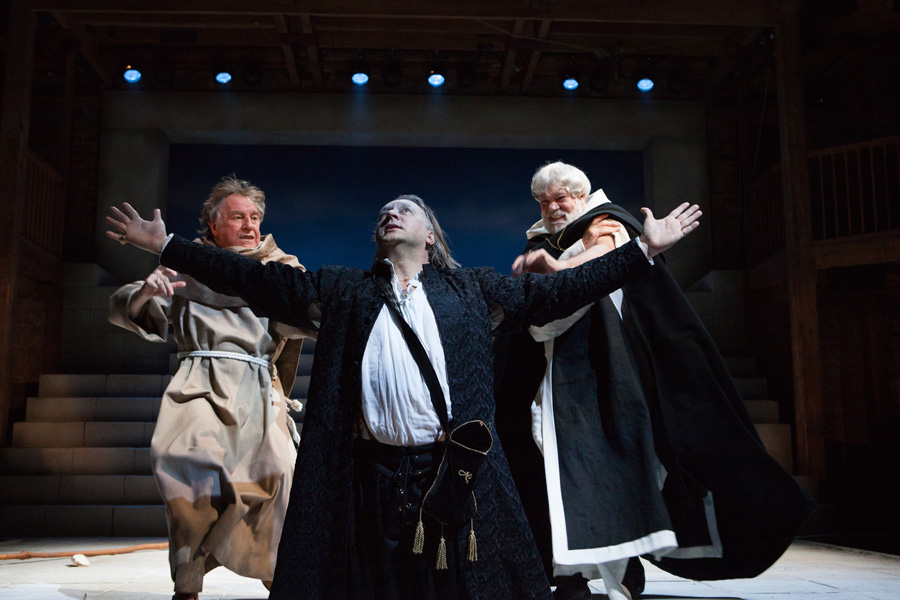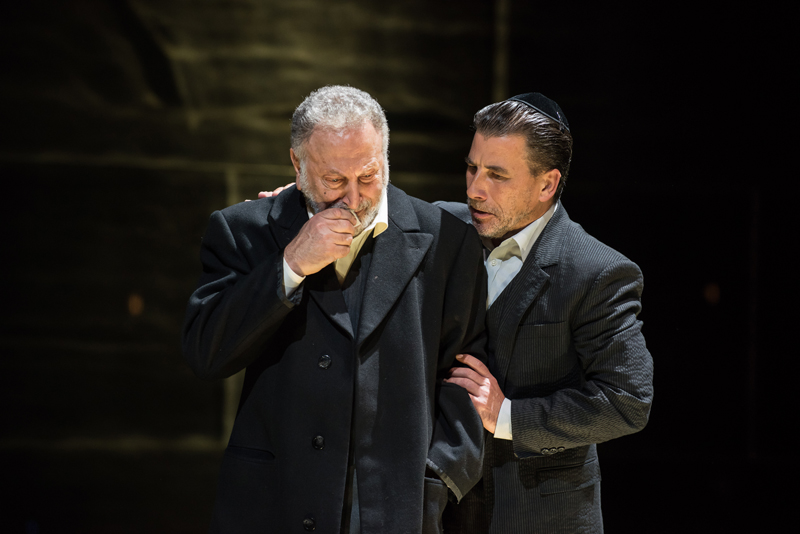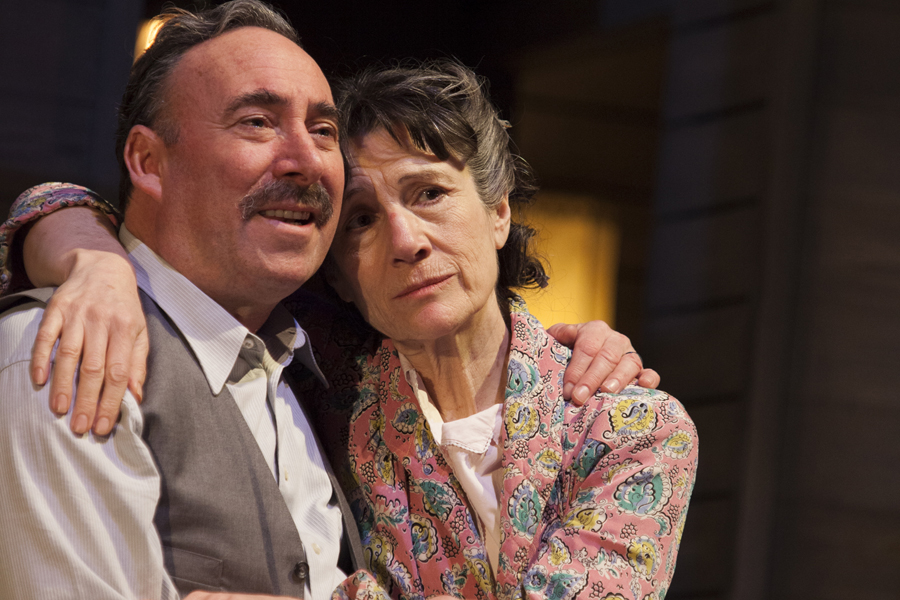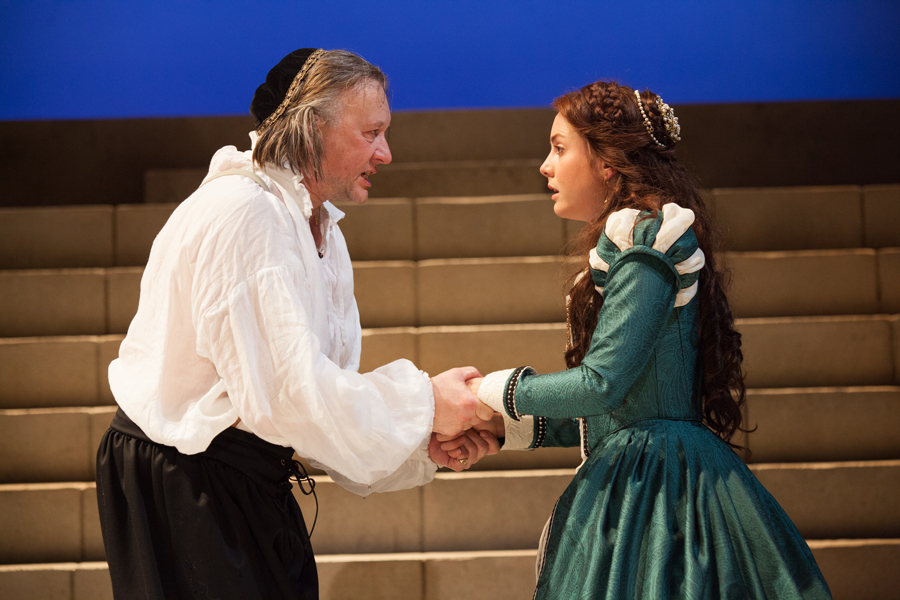Sir Antony Sher was one of the great actors of our time, perhaps best known for his outstanding performances with the Royal Shakespeare Company from the 1980s to his trilogy as Falstaff (2014), Willy Loman in Arthur Miller’s Death of a Salesman (2015) and Lear (2016, 2018), all…
Faith floods Coventry this weekend
First Encounters: Merchant of Venice ★★★★★
Shakespeare by numbers
Review: King Lear ★★★★ – Antony Sher is every inch a king in Gregory Doran's mighty production
 Antony Sher's performance is literally towering at the opening of the play, directed by his husband, RSC Artistic Director Gregory Doran. Lear is borne in on a huge platform above the glittering monochrome of his court (designer Niki Turner), wrapped in fur cloaks that make him larger than life, his every pronouncement accompanied by thunderous chords to make of him a primitive demigod. He may look "every inch a king", as he says ironically later in the strange lucidity of his madness on the cliffs at Dover, but he is equally a very foolish old man, as he also refers to himself later. His rejection of youngest daughter Cordelia (Natalie Simpson, all quiet resolution in white) is especially cruel, arbitrary and yes, senile, simply because of that god-like build up.
Antony Sher's performance is literally towering at the opening of the play, directed by his husband, RSC Artistic Director Gregory Doran. Lear is borne in on a huge platform above the glittering monochrome of his court (designer Niki Turner), wrapped in fur cloaks that make him larger than life, his every pronouncement accompanied by thunderous chords to make of him a primitive demigod. He may look "every inch a king", as he says ironically later in the strange lucidity of his madness on the cliffs at Dover, but he is equally a very foolish old man, as he also refers to himself later. His rejection of youngest daughter Cordelia (Natalie Simpson, all quiet resolution in white) is especially cruel, arbitrary and yes, senile, simply because of that god-like build up.
But it is the reaction of oldest daughter Goneril (excellent Nia Gwynne, an auburn-plaited Saxon princess in russet jewel-encrusted gown) that is most startling. Foreboding at the impropriety of his asking his daughters how much they love him turns to horror on Goneril's face, as her father turns the full force of his cruel rage on Cordelia for her honest reply. Goneril’s fears are well-founded of course, for later he curses her womb, and the physicality of Sher's spite as he grabs hold of her in a cruel travesty of an embrace and her momentary hopeful and needy response to it are all the more shocking.
Doran also gives Lear several of the hundred knights demanded to keep for his retinue to carouse with him around his daughter's table, and a downright noisy boorish shower they are too, so that to start with it's hard not to sympathise even with Kelly Williams's vivid scheming middle daughter Regan.
This engaging of sympathy for a child who will ultimately prove unnaturally cruel is echoed in the relationship between David Troughton's exceptional Gloucester and his bastard son Edmund (Paapa Essediu, a villain with a fine sense of irony), clearly nursing a 'legitimate' grievance as his father introduces him to Kent with that well-worn tactless joke about the "sport" he had conceiving him.
The brilliance of both Sher and Troughton is in their ability to engage sympathy once they are changed by what they endure. Sher sloughs off the layers of clothing that make him imposing from the outside, as he gradually gets to know himself and understand reality and, for the first time, other people. If he is touching in his madness on those cliffs, it's because he is content – even happy – in that altered state (in the way that dementia patients often present for example). The audience learns to love him as he learns himself and is truly reunited with Cordelia.
The parallel reunion between Gloucester, who only sees clearly once he has lost his sight, and his true loving son Edgar, forced to disguise himself as a mad beggar when Edmund convinces his father he’s the villain, is equally moving thanks to Oliver Johnstone's resourceful Edgar, proving ultimate filial devotion as his father, like Lear, achieves closure at life's end.
By Judi Herman
Photos by Ellie Kurttz © RSC
King Lear runs until Saturday 15 October, 7.15pm & 1.30pm, £16-£70, at the Royal Shakespeare Theatre, Stratford-upon-Avon, CV37 6BB; 01789 403493. Then at the Barbican Theatre, London, ECY2Y 8DS; 020 7638 889, 10 November to 23 December, 7.15pm & 1.30pm £25-£55 . In cinemas from 12 October.
Review: On her third helping of The Merchant of Venice, Judi Herman has a discomfiting but enthralling evening
Don't let the buggers grind you down. Try to come over as laid back. They wear a strange eclectic mix of what they see as achingly trendy, or sharp city wear, set off with flamboyant footwear in bright – too bright – poster colours. So wear a dingy blouson over an old cardigan and keep your dignity, simply wipe off their spit when they show their contempt for you. This could be what's going through Shylock's mind in Makram J Khoury's finely calibrated performance, which positively radiates a relaxed gravitas.
It is to be hoped that Khoury, the popular, award-winning Palestinian-Israeli actor didn't base it too closely on his experience as a man caught between two worlds in his native country. Certainly when Christian Venice shows its contempt by spitting on Shylock's "Jewish gabardine", the gasp of horror that runs through the audience is even more of a shock wave than the similar audience reaction when this treatment is meted out to Jonathan Pryce's dignified Shylock at Shakespeare's Globe.
Khoury’s trajectory is frighteningly clear here, from distracted father outraged by his daughter Jessica’s's elopement and her profligate spending and disregard for her dead mother's ring, to vengeful would-be killer. Given the special disgust displayed towards him by Jamie Ballard's alarmingly volatile Antonio, it's hardly surprising he seizes the opportunity to whet his knife and prepare his scales in open court, now entirely indifferent to what the hostile Christians make of his behaviour.
This is the third time this year that I have seen this problematical play and each time I am struck by how little stage time Shylock shares with Jessica. Shakespeare magnifies the awkwardness of what today would be dubbed their dysfunctional relationship by showing so little of it onstage. And, in the few moments they do share together, Jessica is in turmoil over her imminent elopement and the need to deceive her father to make her escape. Here director Polly Findlay and designer Johannes Schültz trap Scarlett Brookes’ awkward, gawky Jessica at an impossibly high window in her father’s house. So there even less connection as he leaves for the dinner with his new creditor Bassanio that will give her the window of opportunity she needs to escape with her Christian lover Lorenzo (James Corrigan), as well as her father’s jewels and ducats.
Indeed Findlay, sharing her vision with Schültz and costume designer Anette Guther, builds an especially alienating dystopic Venice, where it’s easy for the audience to share Shylock’s discomfiture. Belmont, wealthy heiress Portia‘s nearby estate, similarly offers little in the way of refuge, even to its owner and her chosen guests from the city, let alone the foreign suitors at whom this Venetian lady pokes fun. The audience is reflected in the huge brass mirrored wall atop which Jessica appears and there is nowhere to hide on a thrust stage with only a mysterious (and perhaps more distracting than hypnotic) pendulum on which to rest the eye, joined briefly later by three symbolic ‘caskets’ lowered from above.
There is certainly nowhere to hide in Venice or Belmont, from creditors in the city, from the whim of a dead father, controlling his daughter’s choice of husband from beyond the grave. And there is nothing to distract from the actors, who first take the stage from seats on Brechtian benches at the rear. If anything, Guther’s flamboyant, jarringly disparate costumes are the set dressing. Patsy Ferran’s intelligent Portia might be grateful to don sober lawyer’s garments, after the hard poster colours of the little shift dresses that seem to be current Venetian jet set fashion here.
There is, though, a shock awaiting her at court. For at the centre of Findlay’s reading of the play is what turns out to be a love triangle, where Portia sees what the audience has known from the start – she must share her new husband Bassanio (Jacob Fortune-Lloyd) with Ballard’s tortured (and I don’t mean by Shylock), depressive Antonio, who claims him with a desperate kiss as he awaits his fate. It certainly makes sense for Portia to channel her discomfiture and anger into her inspired and literally blood-chilling case against Shylock. So this ‘comedy’ becomes even more of a problem play, if Portia and Bassanio’s wedded bliss looks uncertain before their marriage is even consummated.
Meanwhile, Khoury’s now coldly focused, implacable Shylock makes the most of his day in court, almost whetting his knife on Antonio’s bare chest. No wonder Antonio screams and cringes. And though Shylock loses everything, he is perhaps more incredulous than broken and makes it clear that playing for sympathy - from court or audience – is beneath him. Even he is upstaged by a tsunami of banknotes raining down on the court – effective but perhaps heavy-handed symbolism.
By the time Portia and her faithful waiting gentlewoman Nerissa (an especially warm and literally supportive performance from Nadia Albina – these girls are close) return to Belmont, Jessica and her Lorenzo do not look entirely comfortable with each other either. Jessica seems almost aggressive as she and Lorenzo top each other with their references to pairs of mythical lovers who might have shared such an enchanted night as theirs, alone on Portia’s estate while its mistress is away at court. The magic should have been enhanced by a floor gradually lit by candle after candle filling the stage, the effect doubled by that mirror wall. But their brash brightness is too obvious a visualisation of Lorenzo’s description of "the floor of heaven thick inlaid with patines of bright gold"; the patina on the brass of that mirror would have done nicely. Perhaps the only real beauty in the evening is provided by the choristers, "young-eyed cherubim" indeed, to quote Lorenzo again, singing Marc Tritschler’s unearthly plainsong from the heights of the set. It’s a particularly discomfiting and alienating reading of this difficult play and though the creative vision is clear, it is perhaps too much of a straitjacket for the drama.
By Judi Herman
The Merchant of Venice runs until Wednesday 2 September (broadcast live in cinemas on 22 July). 7pm & 1pm. £5-£60. Royal Shakespeare Theatre, CV37 6BB; 084 4800 1110. www.rsc.org.uk
Review: Death of a Salesman – The RSC's production is a highlight of Arthur Miller's centenary year
 Director Gregory Doran is in no doubt that Arthur Miller's Death of a Salesman is the greatest American play of the 20th Century, addressing not only the heartbreaking conflicts within a family, but also bigger issues of national values and uncritical acceptance of the American Dream.
Director Gregory Doran is in no doubt that Arthur Miller's Death of a Salesman is the greatest American play of the 20th Century, addressing not only the heartbreaking conflicts within a family, but also bigger issues of national values and uncritical acceptance of the American Dream.
After a life of honest toil, Willy wants to stop travelling, pay off the mortgage and bask in the success of his two sons. But he can’t come to terms with the fact that his life and the lives of his boys are so different from his dreams of wealth and triumph. Miller explores the tragedy of what happens to a man who does not have a grip on the forces of life, as he puts it, whose career is disintegrating and the toll this takes on relationships between family members.
Miller was the son of Austrian-Jewish immigrants. His father worked his way up in New York's Lower East Side garment industry to become a wealthy man. The family lived in Manhattan until they lost it all in the depression and withdrew across the bridge to Brooklyn. As a teenager Miller worked to help supplement the family income with a bread delivery round before school. And he saw at first hand men like his salesman uncle Manny who sold not so much their product as their personality. Indeed, Miller is careful not to reveal what products Willy sells, leaving each audience member to furnish their own and make a closer connection to this everyman left battered and broken by capitalism.
Part of the challenge of the play comes from Miller’s extensive use of what he calls the continuous present – not quite flashbacks but simultaneous layers of memory. This means the actors have to shift almost instantaneously into playing a range of different ages and psychological states, and the production too must find ways of mirroring the layers.
Antony Sher is outstanding as the weary, manic-depressive Willy, from his iconic entrance – “tired to the death” – lugging his two heavy sample cases, through to the man who “realised that selling was the greatest career a man could want”, to the sad soul who opines that "After all the highways and the trains and the appointments and the years, you end up worth more dead than alive.” Sher’s performance brings out the contradictions in Willy that make him an irritating noodge (insistent bore) and a man whom it is hard not to pity.
Harriet Walter’s Linda is extraordinary. She gives a wonderfully nuanced account of Willy's doting wife, a woman with complete and blinkered devotion to her husband, who simply refuses to see through Willy’s lies and resignedly accepts whatever the "American Dream" throws at her. In a finely restrained performance, Walter seamlessly transitions between younger and older Linda, her face apparently visibly ageing and then losing its lines again. She is heartbreaking as she pleads on his behalf: “I don't say he's a great man. Willy Loman never made a lot of money. His name was never in the paper. He's not the finest character that ever lived. But he's a human being, and a terrible thing is happening to him. So attention must be paid. He's not to be allowed to fall in his grave like an old dog. Attention, attention must finally be paid to such a person.”
Father/son relationships are at the heart of the play. Alex Hassell as Bif, Willy’s older son (Hal to Sher’s Falstaff in Henry IV, so the bond between the two actors is palpable) creates a portrait of a flawed man, haunted by his signal failure to fulfil his early promise as a sportsman, unable to hold down a job, a thief who has stolen from his employers and even been to jail. Yet he still manages to be likeable, perhaps because he values simple pleasures over the rat race. Like his father, he is at once infuriating and touching. Sam Marks is equally convincing as womanising younger brother Happy, as a young version of Willy, reframing situations so they are more acceptable to him. Again, both actors display remarkable ability to switch convincingly between playing younger and older.
Set designer Stephen Brimson Lewis makes clever use of the Royal Shakespeare Company’s thrust stage to deliver people and furniture for the scenes in Willy’s head against a backdrop of high-rise Brooklyn, all fire escapes and windows. Tim Mitchell cleverly lights the semi-transparent set to reflect the transitions between memory and reality.
Miller originally conceived the play to be happening entirely in Willy’s head and Gregory Doran’s production blends time and space so the audience finds itself at the same time both in the film directed by Willy’s mind and in the ‘real world’ of the play. Perhaps the message of Miller’s play is that the American Dream is as much an expression of the internal movie each of the characters runs as the external idea of a life of personal happiness and material comfort.
Unsurprisingly this production, another highlight of Miller’s centenary year, is to transfer to London’s West End as soon as it finishes its run in Stratford-on-Avon.
By Judi Herman
Death of a Salesman runs until May 2 in Stratford-on-Avon and May 9 - July 18 in London. 7.15pm & 1.15pm. £2.50-£70. Royal Shakespeare Theatre, CV37 6BB; 084 4800 1110. www.rsc.org.uk 7.30pm & 2pm. £12.25-£59.75. Noël Coward Theatre, St Martin's Lane, WC2N 4AU; 0844 4825140. www.noelcowardtheatre.co.uk
Review: Oppenheimer – A detailed bio-drama about the father of the atomic bomb chills and exhilarates in equal measure
 To make a nuclear bomb, you assemble enriched uranium into a supercritical mass that starts an exponentially growing chain reaction. Tom Morton-Smith’s play assembles the team building the first nuclear bomb and shows the chain reaction that ensues amongst them. And just as a bomb needs a trigger, the “Manhattan Project” needed J Robert Oppenheimer.
To make a nuclear bomb, you assemble enriched uranium into a supercritical mass that starts an exponentially growing chain reaction. Tom Morton-Smith’s play assembles the team building the first nuclear bomb and shows the chain reaction that ensues amongst them. And just as a bomb needs a trigger, the “Manhattan Project” needed J Robert Oppenheimer.
The play questions whether the physicists were mad scientists who should have known better than to participate in such a project and how far they felt justified at the time, even if subsequently doubting the genie they had unleashed that cannot be put back in the bottle.
Morton-Smith sees the events through the lens of Oppenheimer, intertwining his intellectual struggle with the physics and his emotional struggle with the need to abandon his early and fervent embrace of communism, which Oppenheimer saw as the only remedy to Fascism, in order to appease the US authorities. He had after all been schooled at New York’s Ethical Culture School, where many of his fellow pupils were also secular Jews and where he discovered the ethical teachings of Judaism. And later he was engaged by other ethical texts and scriptures including the Bhagavad Gita (a 700-verse Hindu scripture in Sanskrit), which stayed with him all his life and Morton-Smith has him quote it at the end of the play.
J Robert Oppenheimer (the J stands for Julius) may have been born in Manhattan, but as the son of German-Jewish immigrants, he was acutely aware of the fate overtaking Europe’s Jews, especially as the US scientific community welcomed an influx of eminent Jewish physicists seeking refuge from the Nazis. The list of characters in the play is in part a roll call of these brilliant fugitives, most of whom would go on to win Nobel Prizes. In addition, the young prodigy had studied under (Jewish-born) Max Born in Göttingen in Germany in the 1920s, gaining his PhD at age 22. So he was much exercised by the rise of fascism in Europe.
After a brief lecture from Oppenheimer, with the audience cast as students, Morton-Smith starts the action with an upbeat party scene on the Berkeley Campus at a Communist fundraiser for International Brigade members off to fight fascism in Spain. It’s the sort of party at which anyone who’s anyone in the intellectual and academic community must be seen. Morton-Smith’s brilliance is to cut between the party and the students and academics in full creative flight as they learn and teach in the lab – using the stage floor as a chalkboard on which they feverishly scribble theorems and theories. Even the chronically unscientific members of the audience (among whose number I count myself) immediately get the feel of how engrossing and exhilarating the pursuit of scientific knowledge and discovery must be for members of the scientific community. This works especially well as a counterpoint to the party segments – all choreographed with huge panache by Scott Ambler.
Everyone in this community is aware of the work of German scientist Werner Heisenberg and his Danish-Jewish mentor Niels Bohr in Europe (as brilliantly imagined in Michael Frayn’s play Copenhagen). Is Bohr making a stand against letting Hitler get anywhere near the bomb? Does Heisenberg dread the ‘fall-out’ from The USA getting there first? Well, clearly in the USA they see it as a necessity to get there first and scientists are under intense pressure to do so. But Morton-Smith imagines, with the feel of chilling authenticity, not only the pressure but also the febrile excitement of these extraordinarily focused (often one-track) minds as they realise they are nearing a breakthrough, albeit one that will prove deadly to millions. The detachment with which the boffins discuss the bombs they call Little Boy and Fat Man and what they are capable of, with a matter-of-factness about the numbers of Japanese likely to be sacrificed, is frighteningly convincing.
John Heffernan brilliantly inhabits the persona of Oppenheimer, mesmerisingly charismatic from the moment he engages with the audience at curtain up. He embodies the struggles and contradictions in the man – a womaniser with “a core of cold iron” – with a wife and mistress; scared that he has the scientific ability “to murder every last soul on the planet, yet at the same time a leader who expects to be followed. And indeed he is the magnet that attracts a huge number of scientists to join him at Los Alamos to work on the Manhattan Project.
Morton-Smith creates wonderfully authentic communities and he plays up the friction between the unruly scientists and the military with their, ahem, 'military' precision at Los Alamos to terrific and rather comedic effect.
Morton-Smith’s portraits of Oppenheimer’s women are especially complex. There’s Catherine Steadman’s mercurial manic depressive Jean Tatlock, the mistress who checks in and out of his life, in her element rallying the intellectuals for the communist cause. And Thomasin Rand’s wonderfully vivid Kitty, another bright and frustrated female intellect, who leaves her previous husband to marry Oppenheimer, only to find herself reluctantly kicking her heels though not her alcohol habit through pregnancies before and during her stay at Los Alamos.
Angus Jackson directs with panache a large cast in a production that sweeps effortlessly from those cocktail parties in Berkeley to the then empty plain of Los Alamos, thanks to designer Robert Innes Hopkins, whose costumes – especially for the women – are both authentic and stunning, and the action is heightened by Grant Oldman’s exhilarating score played live by a superb six-piece band directed by Jonathan Williams, and that organic choreography by Scott Ambler.
By Judi Herman
Oppenheimer runs until Saturday 23 May. 7.30pm, 2pm (Wed/Sun only). £25-£49.50. Vaudeville Theatre, 404 Strand, WC2R 0NH. www.vaudeville-theatre.co.uk
Review: The Jew of Malta – Bracingly amoral violence on the island of Malta (circa 1565)
 The different faiths are rubbing along together until politics and money get in the way and then all sides justify their actions as religious duty and malicious antisemitism provides a rationale for action. Not the Middle East today but Malta circa 1565 in Marlowe’s play, The Jew of Malta.
The different faiths are rubbing along together until politics and money get in the way and then all sides justify their actions as religious duty and malicious antisemitism provides a rationale for action. Not the Middle East today but Malta circa 1565 in Marlowe’s play, The Jew of Malta.
Here Malta is ruled by the Knights of St John (Knights Hospitaller) under Governor Ferneze, ostensibly as an outpost against the Ottoman Turks, although Ferneze is happy to pay the Turks protection money not to be invaded by them. Barabas is the richest merchant in the region but Ferneze plunders his fortune to pay off the threatening Ottomans. The Christian Knights justify taking his money – as a Jew, Barabas is cursed and sinful. He is understandably indignant: “What, bring you Scripture to confirm your wrongs? Preach me not out of my possessions.”
This is evidently a revenge tragedy – the dominant motive is revenge, here for a series of very real injuries. But Marlowe’s play goes beyond revenge, satirising religious hypocrisy, statesmanship and the human condition. We know where Marlowe stands when the Prologue, in the person of Machievel(li) says, “I, Machievel, count religion but a childish toy. And hold there is no sin but ignorance.” No one individual or community’s stupidity or vices are spared Marlowe’s ridicule and criticism in what might be the earliest film noir script.
Because this injustice is the trigger for Barabas to embark on a road to hell paved with anything but good intentions. Nobody – Christian, Turk, or even Jew – is safe from his increasingly bloody revenge, especially once he finds a kindred spirit in a newly-purchased slave Ithamore, and together they revel in ever more ingenious methods of murder and even mass slaughter.
At first sight, Marlowe’s play, with its eponymous anti-hero Barabas (whose namesake is the criminal released by Pilate instead of Jesus, at the behest of a Jewish mob according to the Christian Gospels), looks even more uncomfortable viewing for a Jewish audience than The Merchant of Venice. And it seems like a worryingly timely revival in the light of recent antisemitism. But 16th-century Malta is a bear pit where Turks and Christians fight indiscriminately and Marlowe allows Barabas to have the stage to himself to confide in his audience before they get to meet any of the island’s other amoral schemers (including a brace of villainous friars) who are, after all, after his money – or his fair daughter Abigail. And even before Barabas appears, his gleeful Machiavellian plotting comes with the endorsement of Machiavelli himself in that prologue.
Director Justin Audibert’s exhilarating revival points up Marlowe’s vicious humour and intelligence with Jasper Britton’s ruthless Jew as its poster boy. It has all the colour and sweep of a Renaissance painting, thanks to designer Lily Arnold’s glorious vision. Her staging is simple – marble-like steps sweep down from an upper level to the lower thrust stage which has as its focus a trough of water that proves wonderfully useful. And she fills the space with an entrancing palette of colour on costumes that swirl around the place, enhancing Lucy Cullingford’s choreography and in their turn enhanced by Oliver Fenwick’s lighting.
Audibert’s cast clearly enjoy creating equally colourful characters, led by Britton’s frighteningly practical and fearsomely intelligent Barabas, and Lanre Malaolu’s gleeful Ithamore, revelling in his promotion to partner in crime. Geoffrey Freshwater and Matthew Kelly, as those two wicked friars, make as gleeful a pair of plotters as any on the Renaissance stage. There’s attractively seductive work from Beth Cordingley’s avaricious courtesan, and Catrin Stewart makes a feisty Abigail, hand in glove with her father until… Well, that would telling, you’ll have to go and see it to find out!
The terrifc ad hoc klezmer band has added value for those in the know. The pre-show music is traditional wedding fare, ‘Chosen Kallah Mazel Tov’ ('Good Luck to Groom and Bride') and the show opens with another Jewish wedding staple – Barabas leads the cast singing ‘Erev Shel Shoshanim’ ('Evening of Roses') from the Song of Songs, in the popular setting by Yosef Harar and Moshe Dor (timed well for the production’s early April opening as it is part of the Passover Service too). And throughout the show Gareth Ellis’s musicians bring their own colour to the action, thanks also to Jonathan Girling’s original music.
Does it all leave a bad taste in the mouth though, as the action reaches its apocalyptic climax? By that time, everyone has behaved badly and Barabas is not the only one to face retribution. So however Marlowe’s contemporaries reacted, modern audiences are no more likely to burst into gleeful laughter than they would at the climax of Stephen Sondheim’s Sweeney Todd.
By Judi Herman
The Jew of Malta runs until Tuesday 8 September. 7.30pm & 1.30pm. £5-£45. Swan Theatre, Straford-On-Avon CV37 7LS; 084 4800 1110. www.rsc.org.uk












